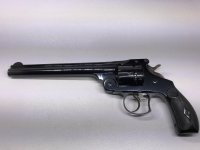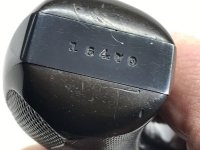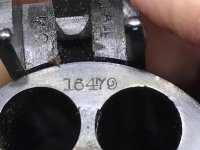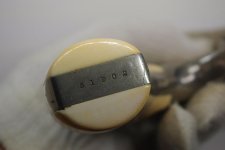Oldmanwesson
Member
This is apparently Walter Roper's 44 DA First Model, with an 8-inch barrel. Roy Jinks has had a look at it and conjectured that it was rebarelled when it was restored at the factory in 1930. This is based on his research of the original factory shipping ledgers which puts this gun into 1886, and having been shipped with a 6 inch barrel to MW Robinson. Looking at the gun I am wondering however how they managed to get a new barrel with the same serial number in the same font as the original some 44 years later. When you look at the numbers closely you see that the last digit "9" is a peculiar "squiggle" - something I have not seen on any other S&W I own, except a New Model No. 3 which was shipped in 1902. The number "7" is different too, and matches the font on the frame and cylinder. The New Model was available with a 8 inch barrel, so did this barrel come from a New Model, or was the barrel length mis-stated on the original ledger? The cartridge marking on the side of the barrel could be for either a Double Action or a New Model. Since the S&W top break barrels are forged with the hinge integral to the barrel, it's not just a matter of screwing a longer barrel into the frame like you can on a solid frame revolver. This thing had to be custom made, if it did not already exist. Frankly, it has me stumped...
The box it came in is also a bit of a mystery. The label refers to "the man that made the new barrel possible" - does that refer to Roper, or to the gunsmith who matched the 8 inch barrel to the frame? The second label has Walter's address on it and was obviously affixed after the first label. So, did Walter write the first label, and S&W put on the second? Or did Walter put on both labels, the second as his return address in case the gun and box got misplaced? The second label looks like it was cut out of a personalized envelope and the words "Smith & Wesson Springfield Mass." written in pencil underneath. Why would he need to address it to S&W? They already know who they are. According to Roy, the box is a correct 1920's S&W service department return box.
Walter Roper, by the way, was sales manager at S&W in the 1920's, and a renowned firearms designer and author. Walter designed a style of pistol grips which are still produced today. He also authored at least two books, one on pistol shooting and the other on S&W handguns. He also wrote many articles for a variety of gun magazines.
I know there are a lot of S&W experts here, so someone may have an alternative opinion on this theory...
Let's hear it!
The box it came in is also a bit of a mystery. The label refers to "the man that made the new barrel possible" - does that refer to Roper, or to the gunsmith who matched the 8 inch barrel to the frame? The second label has Walter's address on it and was obviously affixed after the first label. So, did Walter write the first label, and S&W put on the second? Or did Walter put on both labels, the second as his return address in case the gun and box got misplaced? The second label looks like it was cut out of a personalized envelope and the words "Smith & Wesson Springfield Mass." written in pencil underneath. Why would he need to address it to S&W? They already know who they are. According to Roy, the box is a correct 1920's S&W service department return box.
Walter Roper, by the way, was sales manager at S&W in the 1920's, and a renowned firearms designer and author. Walter designed a style of pistol grips which are still produced today. He also authored at least two books, one on pistol shooting and the other on S&W handguns. He also wrote many articles for a variety of gun magazines.
I know there are a lot of S&W experts here, so someone may have an alternative opinion on this theory...
Let's hear it!





